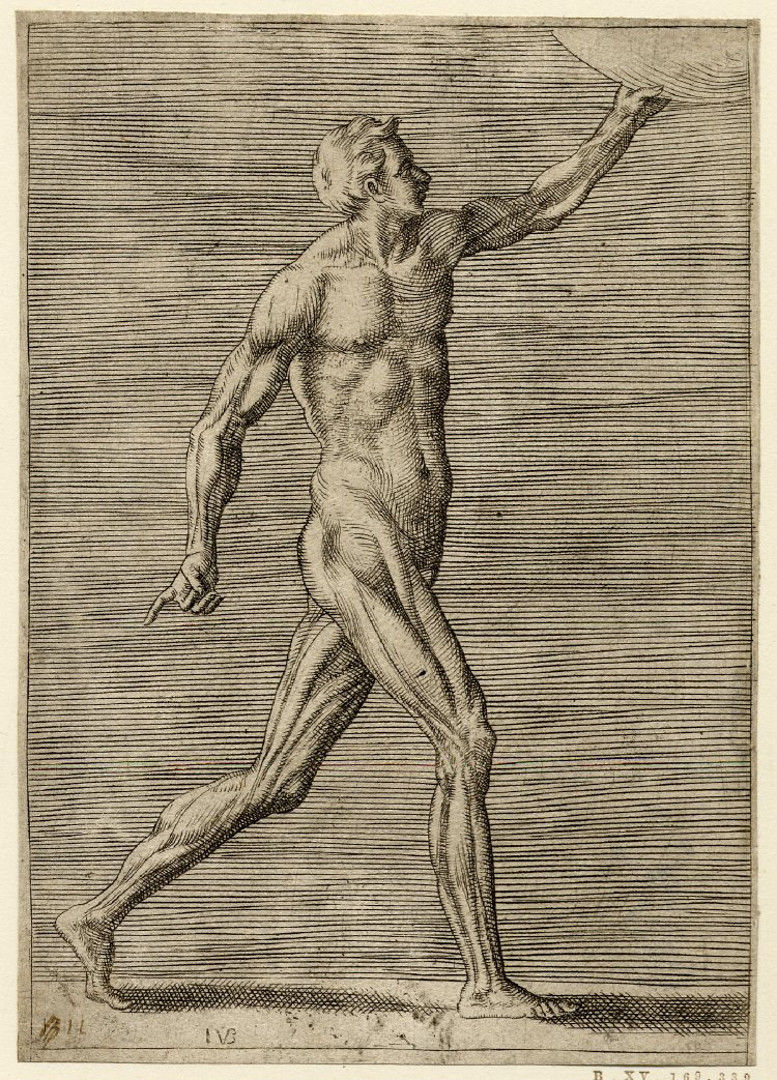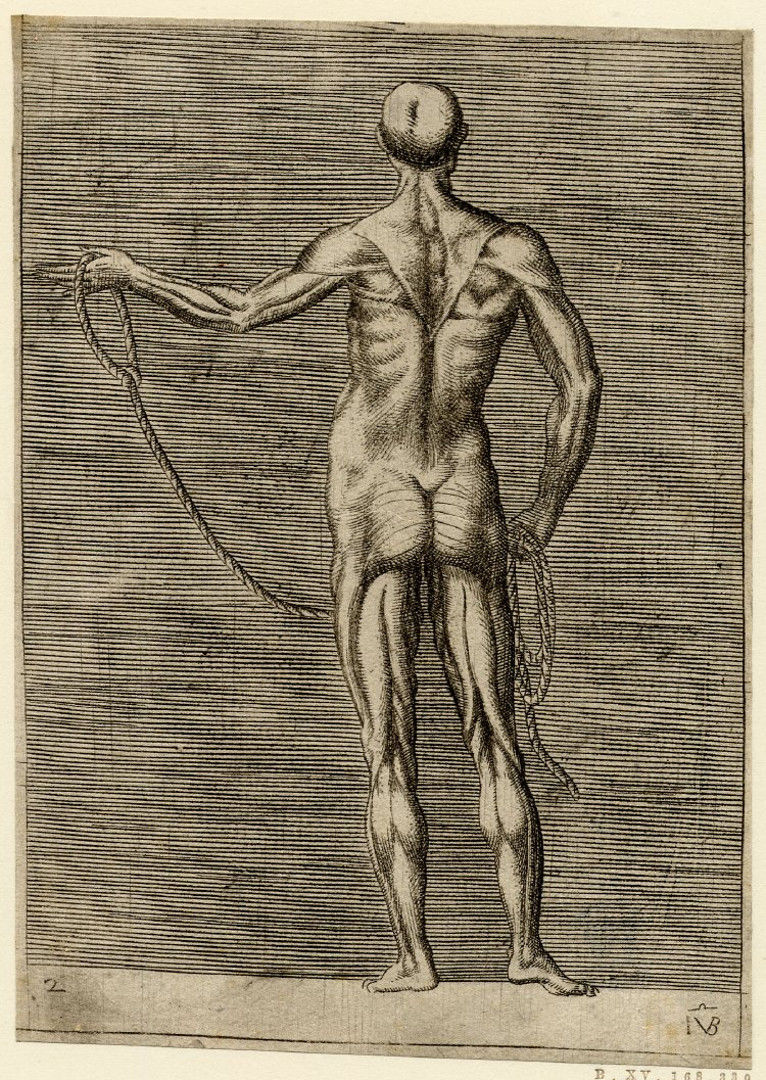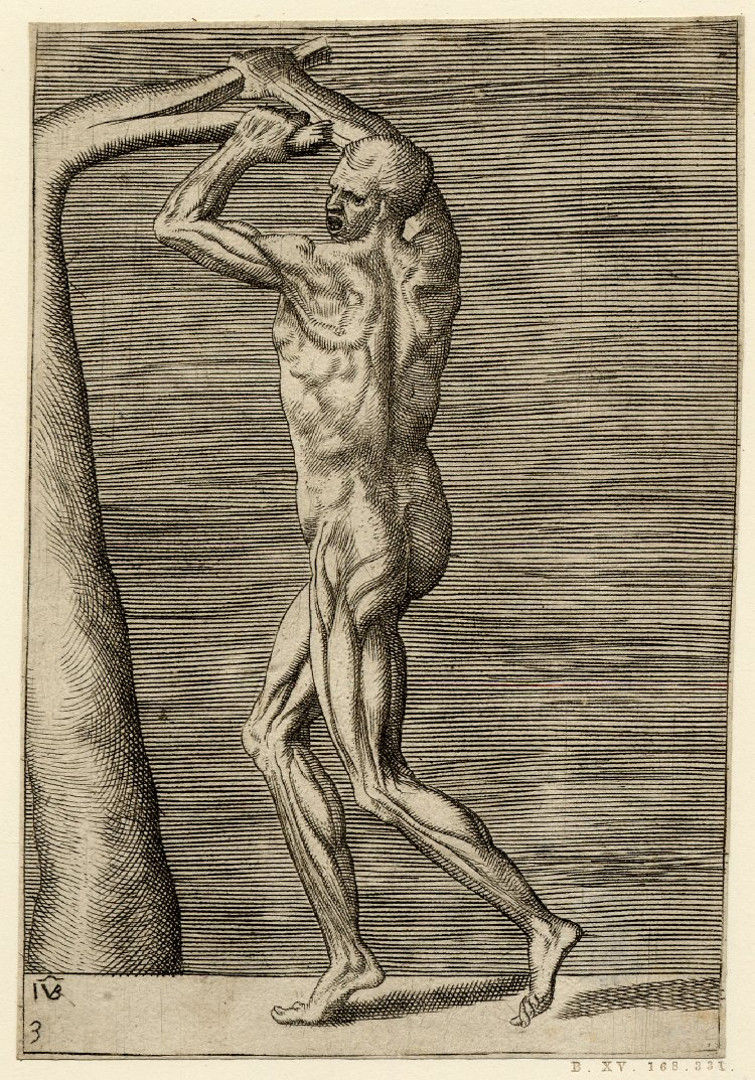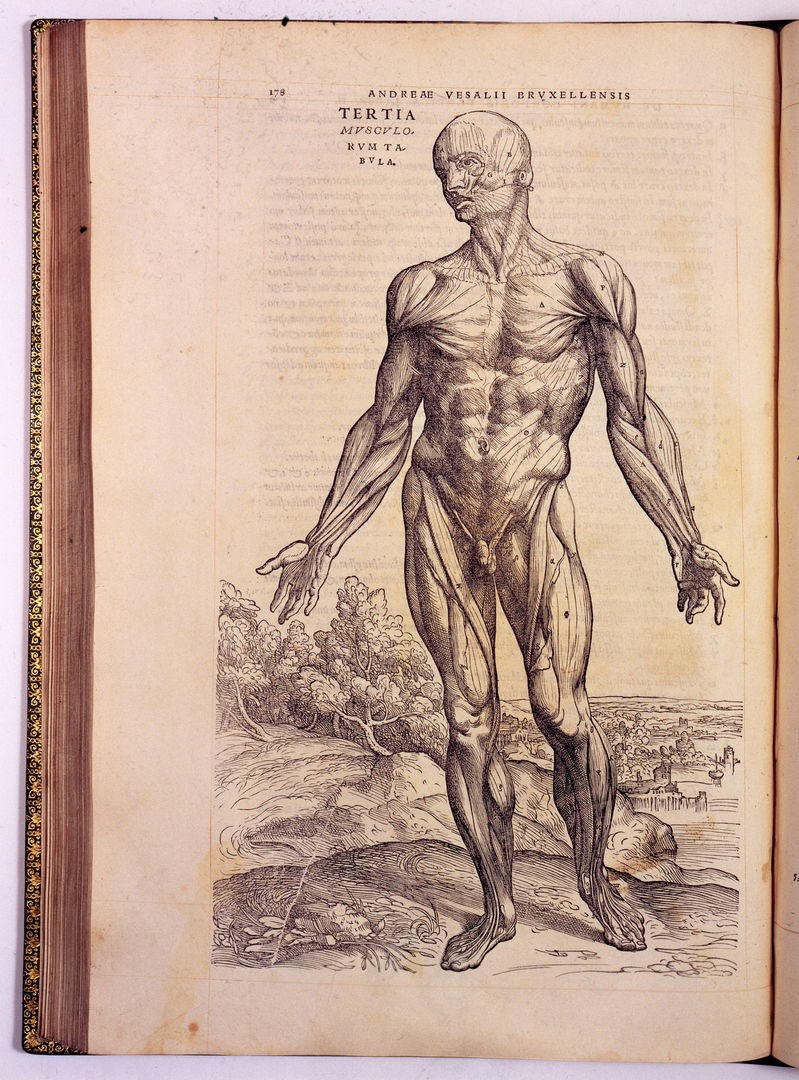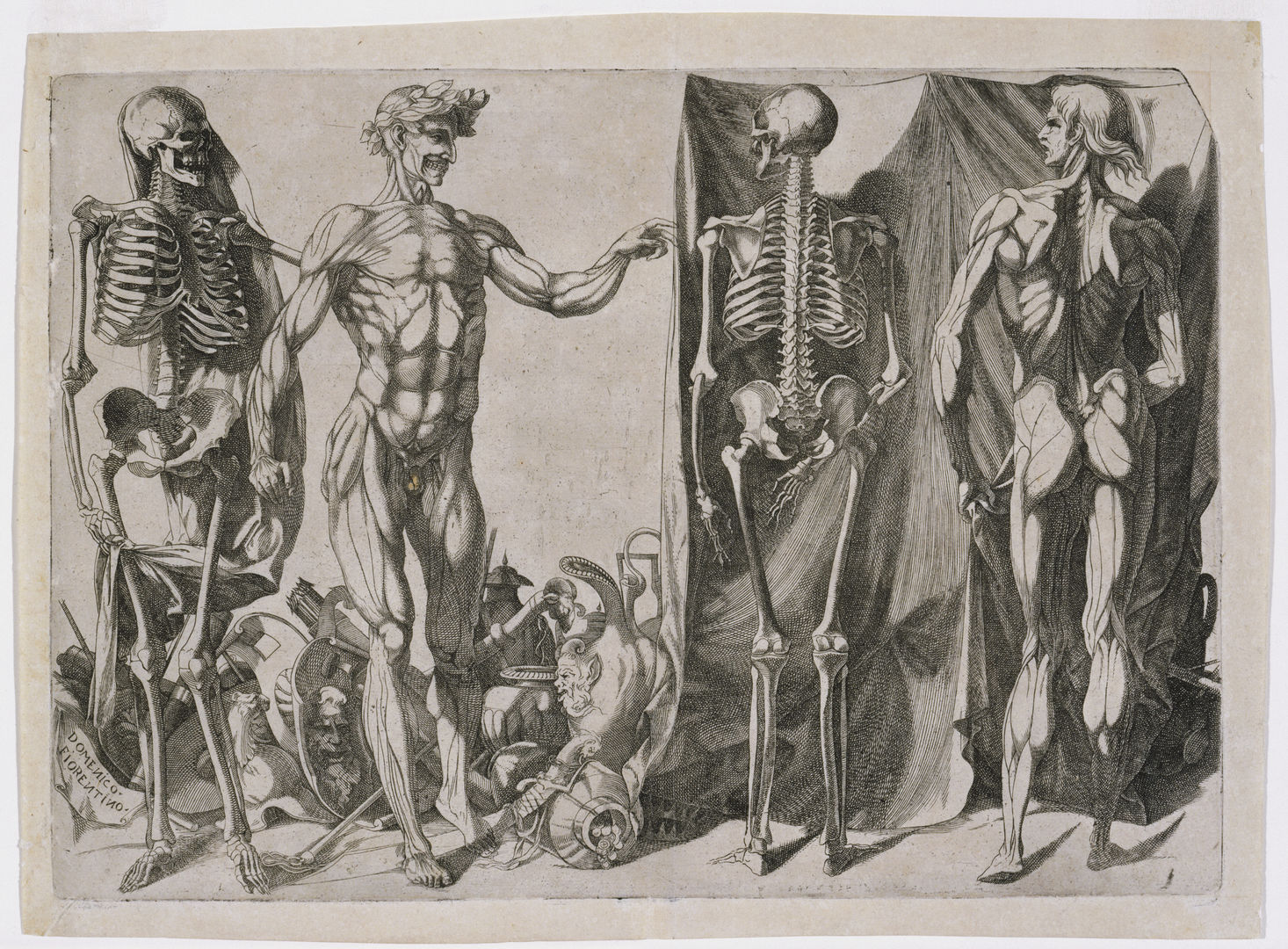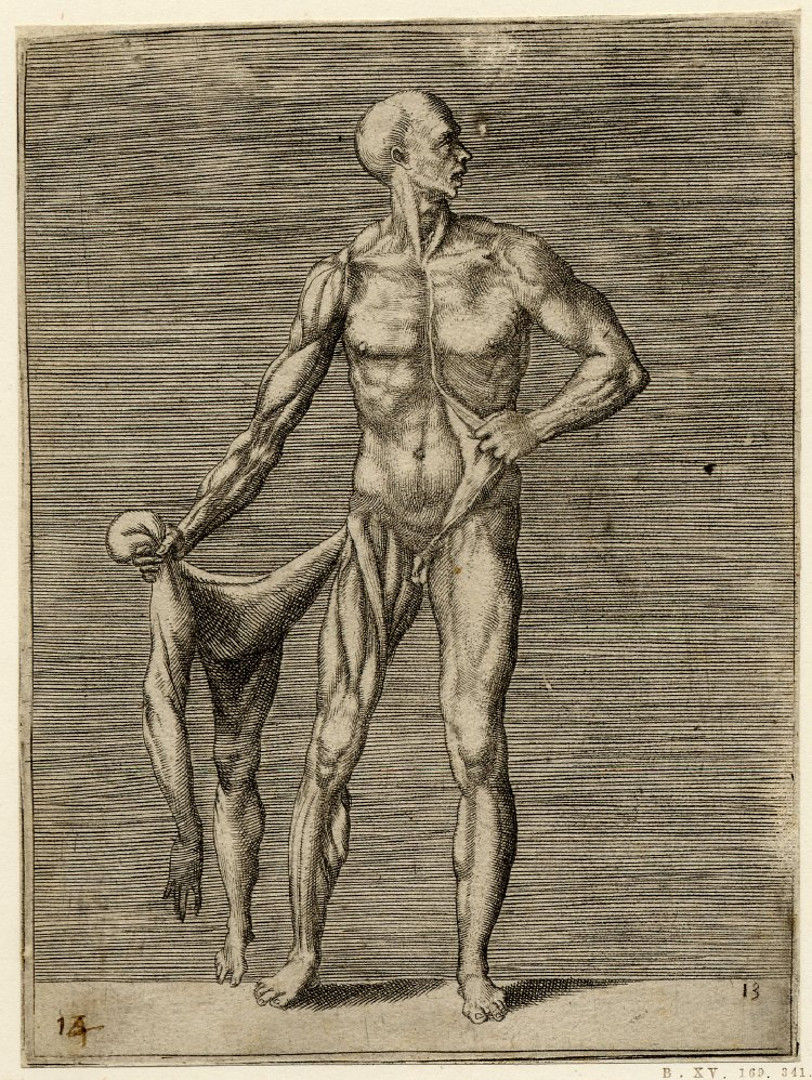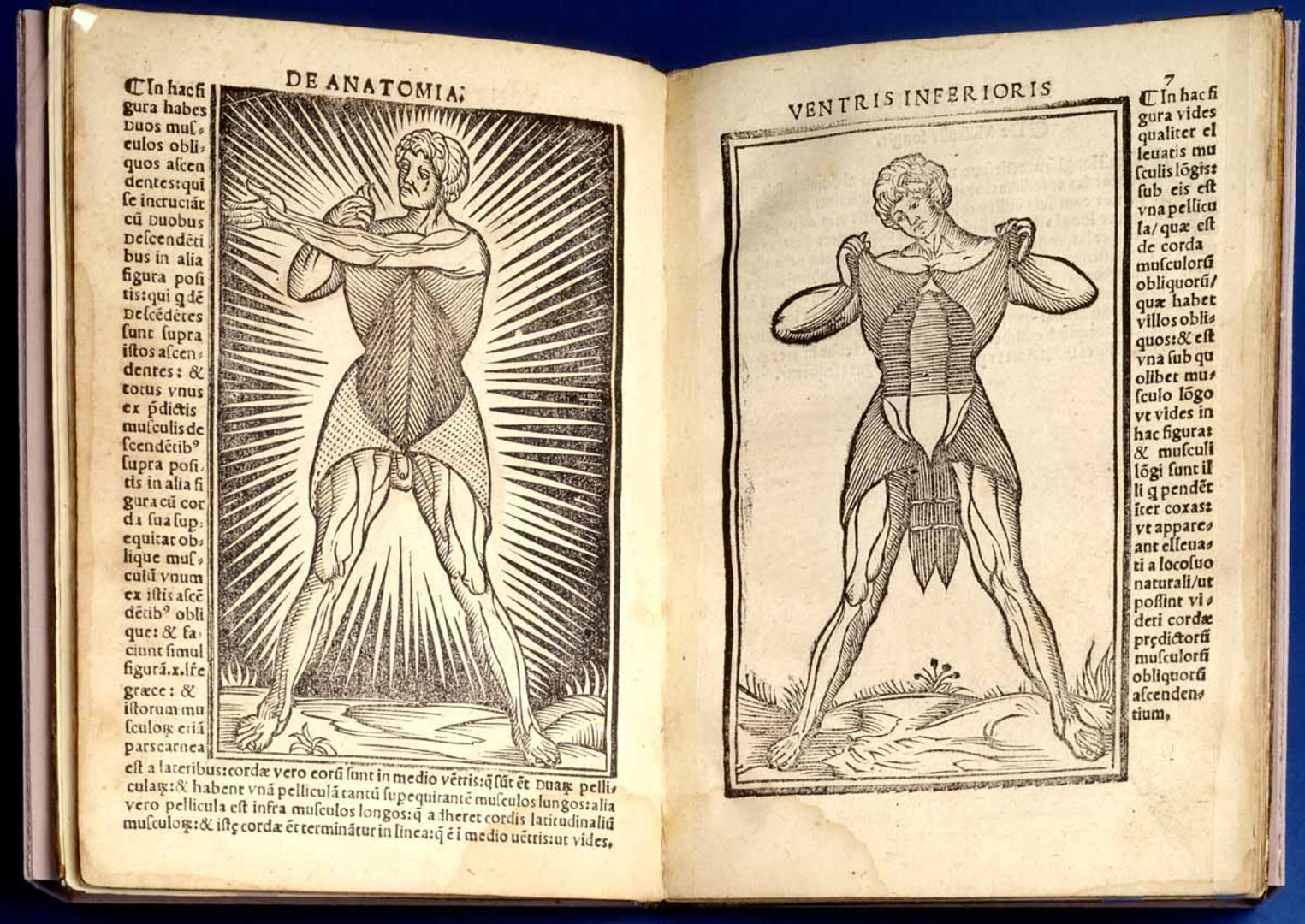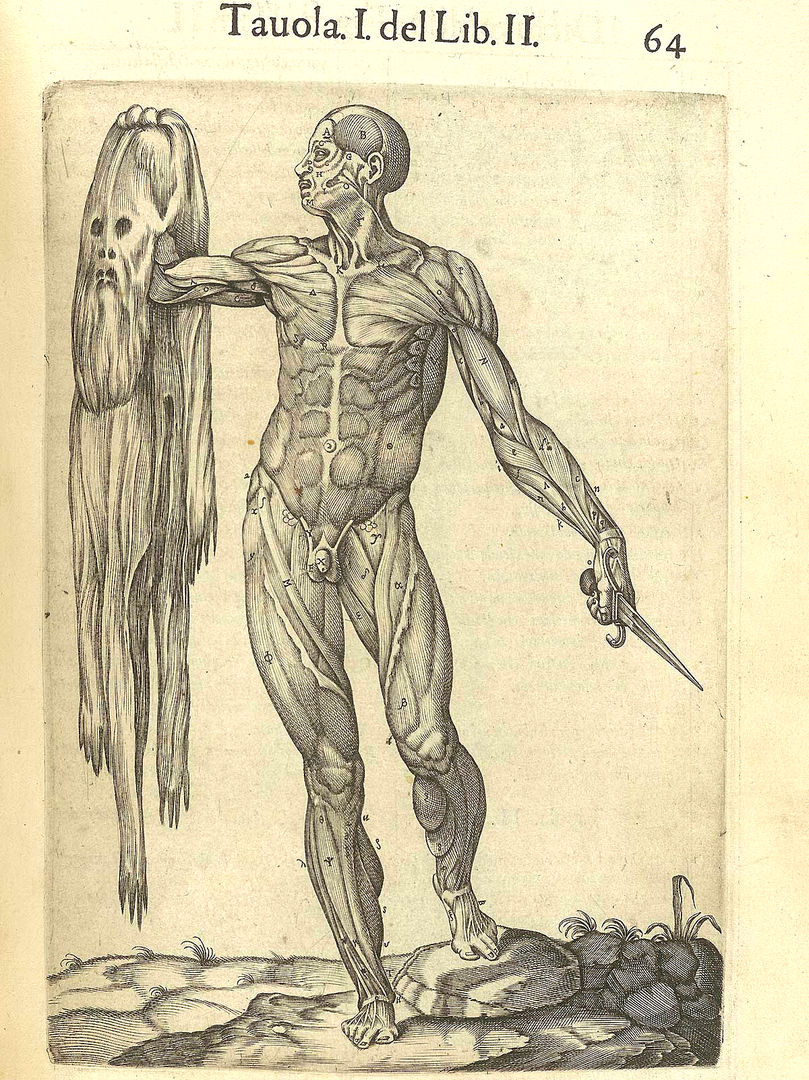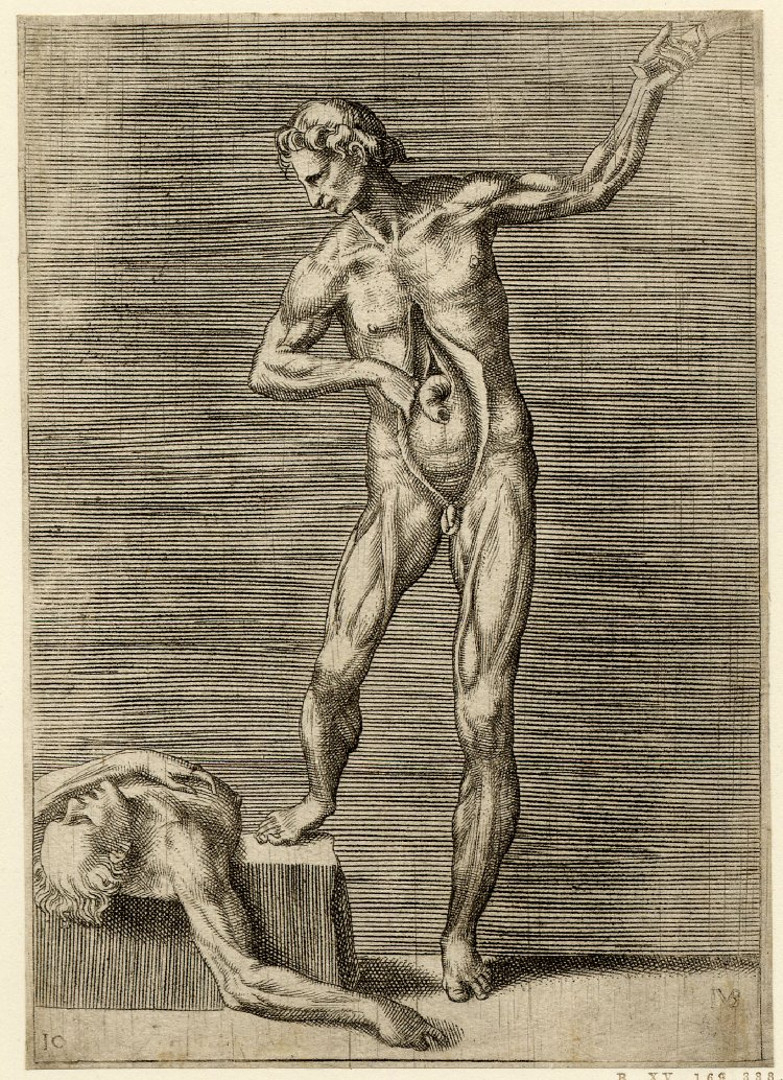|
Translating the physicality of the human body
into visual
representation has always been one of the crucial issues in the
history of western art, and one of the major concerns of artists and
philosophers of the early modern period. The discursive potential of
images concerning the human body encompassed essential categories of
knowledge, because they held the power of either reinforcing or
destabilising the very concept of the reliability of images, and thus
an entire cultural system which relied on the implicit truthfulness
of certain scientific, social and political notions. During the early
modern period, artists, physicians and natural philosophers were
engaged in furious debates regarding these questions, due to forceful
social shifts, extraordinary technological developments and a number
of discoveries occurring simultaneously in the geographical and
anatomical sphere.
This article focuses on a short series of
anatomical prints produced
by Giulio Bonasone, a Bolognese engraver, during the second half of
the sixteenth century. This collection deals with perceptions of the
body and its representation in untraditional ways. Bonasone was a
rather successful artist who worked in Bologna and Rome between 1531
and 1574, and who produced a vast number of engraving and a few
paintings.
In his catalogue Le Peintre Graveur, still an authority in the field
of early modern prints, Adam von Bartsch describes him as a
well-known engraver, prolific and inventive in his figurations but
not always consistent in the quality of his works.
This anatomical series was produced, according to Stefania Massari,
around the early ‘60s of the sixteenth century.
It presents, however, a number of odd, unprecedented features that
set it apart from the abundant production of anatomical studies of
that period. This collection, which comprises fourteen independent
engravings, has not yet been subjected to the analysis it deserves:
this article, then, aims to fill, at least partially, such gap. In
the limited space of this study, my analysis will not include all
images from the series. Rather, it will focus on a few prints that
assume a particular importance in the field of early modern
production and diffusion of knowledge about the human body and its
role in the natural world.
The peculiar qualities of these images is
immediately evident: in
each plate the figures interact with many different objects that are
ambiguous, or even extraneous to traditional visual vocabularies in
the representation of early modern anatomical illustrations (a globe,
ropes, a strange rectangular object, the branch of a dead tree).
(Fig. 1, 2, 3, 4) Many elements and themes present in more famous
images from the fifteenth and sixteenth century, such as the accurate
display of every muscle, organ and limb, or the insertion of the
human figure in some kind of natural or architectural environment,
are strangely absent. The bodies that inhabit these anatomical
illustrations exist in a space deprived of any sort of connotation,
precariously perched on flat, anonymous surfaces. More similar to
antique friezes than to images engraved on paper, each figure stands
out of a dull background made of thick dark lines.
In this article I will posit that these images,
rather than propose
an accurate representation of the human body which could be useful
for medical students, respond to complex social and psychic
implications that were (and still are) inextricably connected to the
violent act of dissection. In the early modern period, the body still
maintained its implicit value as image of God and ideal centre of the
universe: yet, it was on the way to become nothing more than mere
subject of cultural norms, legislations and restrictions. At the same
time, however, the body was starting to assume a crucial role for a
new production of knowledge: it is not casual that the Italian term
sviscerare means not only “to examine, explore, investigate”, but
also, quite literally, “to disembowel, lacerate, destroy”.
Annihilate the body, then, was necessary to know it. A similar
notion, which consequently materialised complex intellectual and
social tensions, was already present during the early modern period,
when the practice of dissecting corpses for didactic reasons was
progressively spreading throughout Europe.
Traditionally, early modern anatomical
illustrations expressed with
emphasis (bordering on the rhetorical) their own intellectual
authority. Thanks to a meticulous attention to detail and faithful
complementarity to textual apparatuses that generally accompanied
them, they claimed a reliability that depended from an absolute
adherence to natural forms. However, it is crucial to keep in mind
that the concept of anatomy as scientific discipline, and the very
notion of “science” itself, was foreign to cultures and practices
of the early modern period.
The ideas concerning nature and all its elements, including the human
body, were not arranged around unmovable categories: producing
knowledge was a fluid process, often based on more visual
representations than the establishing norms, laws and rules. The
artist’s imagination was not dependent from philosophical or
scientific systems, but, on the contrary, was an autonomous creative
tool, which retained its own authority.
One of the essential ideas in the production
and diffusion of this
kind of images was the assimilation of the human body to the divine
configuration of the entire universe. For this reason, illustrations
belonging to treatises of natural history and philosophy usually
represented the human (male) body as an idealised model, the most
complete and perfected expression of nature.
Such a notion combined religious dogmas with influential texts and
philosophies from classical times, among which the famous statement
by Protagoras that “man is the measure of all things”. When
looking at the figures from Giulio Bonasone’s series, it is evident
how the main focal point of these engravings is the variety of
motions, gestures and animations, rather than an idealised
representation of the body. The distorted, extreme facial
expressions, as well as the forced and contrived rendition of the
muscles, indicate a very different purpose. To fully appreciate the
uniqueness of these images, however, it is necessary to contextualise
them in contemporary developments concerning the study of the human
body.
The publication of the seven volumes of the
Fabric of the Human Body
by Andreas Vesalius in 1543 represented, as it is commonly known, a
breakthrough in the modes of perception and representation of the
body. (Fig. 5) This treatise on human anatomy included original
illustrations, richly detailed and directly related to the textual
body (relying on the use of cartouches, inscriptions, annotations).
The Fabric developed and promoted not only an innovative system of
practices related to medicine and the exploration of the body during
dissections, but also a new epistemology based on the human body,
which aimed to find common norms and rule to compensate the (often
troubling) variety of corporeal differences. As I have already
mentioned, the problems inherent in the search for reliability and
truthfulness when reproducing the natural world in image assumed in
the early modern period an even more urgent quality in relation to
the body. These representations epitomised and influenced the
production and diffusion of anatomical knowledge just as much as
contemporary medical discoveries, so that notions of dissection and
personal identity soon became interconnected, if not mutually
dependant.
The innovations brought forth by the Fabric
consisted not simply in
the correction of a few mistakes in Galen’s system of physiology,
to an extent already known but still part of a rigidly solidified
medical knowledge. Rather, as Andrea Carlino argued in his Books of
the Body, Vesalius proposed a new research methodology, through which
he both reinforced the didactic potential of dissection and
introduced a tool for a critical and empirical knowledge of the body,
independent from classical texts.
Vesalius had been the first to realise how practices of dissection
were the only possible guide for a reliable description of the human
body. The method he proposed was at the same time didactic and
investigative, so that body and text worked together to express this
new knowledge. From the Fabric transpires thus a particular emphasis
on the importance of combining visual representations with more
abstract teachings and investigations.
Bonasone’s anatomical engravings, as opposed to
the ones in
Vesalius’ treatise, were not produced for comparative or analytic
studies of the human body. The figures, roughly sketched and
seemingly assembled more at random than following methodical studies,
could not be further away from the normative intent of the Fabric.
While, in Vesalius’ treatise, illustrations follow one another in a
progressive unveiling of the body and its insides, in a path of
discovery parallel to the physical act of reading the book (where
pages become a metaphor for skin, muscles, bones), Bonasone’s
series follows no such methodological device.
It is significant that Bonasone’s engravings
are not referencing
any kind of text. Rather than codifying specific norms and producing
precise, quantifiable information or data, these figures prefer to
communicate with the viewer in more immediate ways, through gestures,
postures and facial expressions. The sense of unease that imbues
these images originates precisely from this non-verbal quality. Of
course, the enigmatic, impenetrable and somewhat macabre atmosphere
of these illustrations belongs to many other early modern
representations of dissections (such as the prints by Charles
Estienne and William Harvey). They all represent, in different ways,
the same nightmarish vision of a corpse coming back to life,
obscenely displaying its muscles, tendons and bones.
Giorgio Agamben argues, in his essay Nudities,
that the desire to
show one’s own flesh, to force the body in incongruous and trivial
positions, is a psychic strategy that aims to destabilise and disavow
the divine essence to which the body, both in theological and
psychoanalytic fields, is inextricably connected. What is revealed,
in these contrived postures, is the explicit and irreparable loss of
this state of grace.
The naked body (and thus also the anatomised body, since the extreme
point of nudity is the one where not only clothes are removed, but
skin itself) as symbol of knowledge refers to philosophico-mystical
discourses, because it embodies precisely the process of discovery,
the appropriation of a specific discourse of knowledge. We are
particularly fascinated by such images, Agamben posits, because they
do not represent reality, the thing, the object, but the essential
possibility to be aware of it, to understand it.
It is then from representations of the body
that it is possible to
extract a more insightful anatomical knowledge. This intuition, with
its somewhat exoteric taste, seems to reverberate in the images I
have discussed so far, precisely due to the way they reproduce and
make the body visible. The figures are situated in a more abstract
and intellectual context, where knowledge is not merely transmitted
but actively created. The links between figures and text, references
to classical art, allegorical themes, natural landscapes and
architectonical ruins are not merely stylistic details, but
iconographical tools that aim to reinforce a specific notion of the
human figure. All these devices contribute not only to the production
and dissemination of ideas on the importance of anatomical studies
(drawing on authoritative classical culture), but also, perhaps, to
mediate between the desire of knowledge and the anguish and guilt
generated by the physical act of dissection, after all still a
heavily stigmatised practice.
Both in Italy and in Europe, corpses were
anatomised in a theatrical
setting, during performances that had strong liturgical undertones.
Anatomy as a practice was subjected to rapid changes: from private
lessons for students of medicine and surgery, it was quickly
transforming into a public spectacle, open to a wide range of
individuals (artists, craftsmen, even casual spectators).
The ritualistic aspect of human dissection, a solemn combination of
public punishment and production of knowledge, norms, conventions, is
a fundamental aspect in early modern culture, and plays an important
role in both the analysis and the understanding of anatomical
representations. As Jonathan Sawday argued in his seminal book The
Body Emblazoned, published in 1995, such dramatic performances merged
theatrical practices, bio-political demonstrations of judicial power,
and philosophical allusions to the divine origin of the human body,
with all its theological implications.
As Sawday points out, the issues of crime and punishment were
inextricably intertwined into many aspects of early modern Italian
culture. Dissection as capital punishment was an established practice
in Italy by the second half of the thirteenth century. It was
designed not only to evoke terror at the idea of the violation of the
body, but also to add another, much more horrifying dimension to the
already harsh sentence: the denial of a Christian burial, which
involved the posthumous – and eternal – punishment of the
criminal’s soul, thus unable to access Heaven.
Moreover, the stigma associated with public dissection also lied in
the dramatic violation of personal and family honour and the
humiliation derived from the public exposure of the naked body.
These issues were definitely present in the minds of artists who
worked on anatomical illustrations, and provoked intense emotive
reactions that emerged in different ways in their production.
It is very likely that Giulio Bonasone himself
assisted to such
spectacles in the renowned anatomical theatre of Bologna. After all,
studying human proportions and acquiring first-hand experience of
human bones, muscles and skin, was considered the mandatory approach
for those who wished to learn how to correctly represent the human
body. It was first Lorenzo Ghiberti in his Commentarii of 1447 to
state that
“It is necessary [for the artist] to have seen
anatomy, so that the
sculptor knows how many bones are in the human body when sculpting a
male statue, and how many muscles are in the body and all the nerves
and ligatures are in it”.
The importance of such statement should not be
underplayed: however,
similar ideas already existed in essence, as Leon Battista Alberti
attests. In his treatise De Pictura of 1435, he advised painters to
represent the nude body drawing the bones first, then the flesh, and
finally the skin, thus assuming that artists had some prior knowledge
of human anatomy.
It is now common knowledge that already in the early sixteenth
century the study of anatomy as a didactic practice for artists was
firmly positioned among the practices of “bella maniera”,
especially after Leonardo’s and Michelangelo’s progresses in the
study of the realistic composition of human figures. Countless
studies of single bones, limbs and muscles remain to us as a proof of
how widespread such anatomical practices were in that period.
The punitive act of flaying was another
practice associated not only
to the study of anatomy and the judiciary system, but also to
artistic activities. According to early modern scholars such as Sarah
Kay, removing the skin as punishment was not only a recourse of law
but also a form of “poetic” or moral justice. While it was
instigated as sentence, it could be reversed into – and even
embraced as – a sort of Christian sacrifice, situating the criminal
in a kind of christological dimension. Thus, the extreme suffering of
such physical and intellectual torture, (since it encompassed
physical pain and definitive loss of identity) could be sublimated
into an abstract, almost spiritual invulnerability.
An interesting detail in relation to the link
between punishment and
anatomy is that each lesson at the anatomical theatre of Bologna
would begin with the formulaic expression “our subject for the
anatomy lesson has been hanged”.
The recurring presence of ropes in Bonasone’s anatomical images
seems to be an explicit reference to this dense culture of
punishment, shame and ritual. It is surprising to notice the almost
insolent attitude of the figure in Plate 2 (Fig. 2) who resolutely
turns away from the viewer. It is as if the corpse is evoking,
through a deliberate denial of eye contact, its own identity loss,
its reduction from man, created in the image of God, to object of
study, no more dominating nature but simply a part of it.
The dual state of the body, stuck between
sacredness and materiality,
seems to be epitomised in Plate 14, (Fig. 3) in which the figure is
literally split in half: on one side, it is still fully fleshed, on
the other only bones remain. Such a figuration was already on the way
to become a common trope in early modern anatomical images, not only
because it offers a comprehensive picture of how bones influence the
motions of the muscles,
but also because it acted as reference to allegorical and
philosophical concepts concerning the temporary nature of the body.
An example of this trend appears, for instance, in an engraving
produced by Domenico del Barbiere after a drawing by Rosso
Fiorentino. (Fig. 6) In this image, two écorchés (flayed bodies)
and two skeletons are showed simultaneously: the exasperated details
in the representation of the muscles and the stretched, unnatural
poses of the bodies reflect the visual vocabulary of the contemporary
mannerist style. The details of the trophies and battle vestiges are
easily recognisable as allegorical references to the ephemeral value
of life’s accomplishments and glories. The mysterious dark curtain
on the right and the cloth that covers the skeleton on the left,
almost a parody of the laurel crown on the head of his flayed
companion, are most likely allusions to the inevitability of death.
In Bonasone’s engravings, however, such allegorical references are
accurately avoided. Moreover, if compared to Domenico del Barbiere’s
skeleton, the one in Plate 14 (Fig. 3) is outlined with scarce
attention to physical accuracy, especially in the detail of the right
hand, which seems still be covered in flesh. The focus is clearly on
the emphatic, demonstrative gesture of the right arm. The enigmatic
rectangular object on which his left hand is posed, maybe a column or
even a stylised tree trunk, contributes to the general feel of
incongruity. But it is perhaps the detail of the facial expression
that generates the gloomy sense of loss and dread that imbues this
engraving. The mouth, open as if emitting a constant lament, and the
eyelids, lowered or maybe open on hollow eye cavities, transform this
figure from a rigorous technical illustration into a terrible vision
from Hell.
Whoever dealt with bodies and their
representations was certainly
well aware of the discursive relationship between the incisions
artists made on metal plaques to produce images and those made on
cadavers during dissections. Prints, easily accessible and
reproducible on a large scale, became in the early modern the
favourite mode of transmission and diffusion of anatomical knowledge,
eventually creating a well-defined style with its own conventions and
recurrent representations. Engraving, a highly skilled craft
characterised by a lengthy process and an uncertain result, was
conceived in consideration of the materials it employs, its nature,
resources and potentialities. Since the medieval period, it was
common to consider the medium, in this case a metal plaque, as a
bearer of a specific meaning per se.
The similarities between the act of peeling the paper from the plate
and ripping the skin from the body could not have passed unnoticed.
Plate 11 of Giulio Bonasone’s anatomical
collection (Fig. 1) shows
a figure holding an object similar to a globe
placed in the upper right angle. Yet, both the pose and the odd
shadowing seem to leave space for another interpretation, one that
takes into account the intersections between engraving and dissecting
the body. In this image, it appears the flayed body is grabbing the
folded angle of the very page it is engraved onto. As the anatomist
strips the skin from a dead body, to discover the inner functions of
a still mysterious organism, so the engraver strips the paper from
the metal plaque to unveil the newly created image, a new site of
knowledge. The skinless corpse seems to be removing another layer of
skin, the layer of the page imprinted on the metal plate, as if
mirroring the same procedures it has been subjected to.
Other images in this collection, such as for
instance Plate 13, (Fig.
7) represent the corpse removing its own skin and holding it as if it
were a cloth or a cloak. Sarah Kay posits that this figuration was
made common by devotional representations of Saint Bartholomew, such
as that in Michelangelo’s Final Judgement in the Sistine Chapel.
More than a popular way of producing images, however, depicting a
corpse flaying itself was both a way to display the features of each
muscle while preserving the unity of the human body, and a strategy
that triggers a deep affective and visceral response.
Self-anatomising corpses populate not only the pages of Vesalius’
Fabric, but appear in the vast majority of texts, even from earlier
times, concerning the body. They are featured, for instance, in
Berengario da Carpi’s Isagogae breves in anatomiam humani corporis,
a medicine treatise published in Bologna in 1523 (Fig. 8) and in
books as famous as the Fabric, such as the immensely popular Historia
de la composicion del cuerpo humano by the spaniard Juan Valverde de
Amusco, printed in Rome in 1556. (Fig. 9) Somewhat in between
plagiarism and genuine attempt of improvement, Valverde famously
borrowed almost the entirety of Vesalius’ illustrations (without
acknowledging his authorship) in some cases combining them together
to produce particularly insightful images, which represent even today
a fertile terrain for the study of early modern practices related to
the body.
In these anatomical illustrations, skin is no
longer perceived as a
mere surface, but becomes instead a more productive site onto which
political, cultural and psychic issues are projected. As it has been
pointed out, the fact that skin (or its representations) can mean at
the same time beauty and abjection, and evoke both attraction and
repulsion, highlights the skin’s potential to bear multiple and at
times contradictory meanings.
And contradictions and ambiguity seem to propagate from body to
printed space in Plate 13. (Fig. 7) The figure’s shadow does not
dissolve into emptiness: instead, it stops abruptly when meeting the
background, suggesting the association of the printed figure to
statuary reliefs. The corpse is represented in the process of
tearing his skin apart, so that its body appears, once again,
splitting in half: one side is still enveloped by skin, while the
other exposes its insides. An uncanny shadow of that same body,
however, seems to emerge from the lump of skin he is holding in his
right hand. An inert mass, somewhat elongated, this formless sack of
skin is transformed into a smaller scale double of the body it comes
from. The skin from the corpse’s arm, slightly twisted, assumes the
shape of a leg. The skin removed from the right leg, instead,
maintains its form, and clearly mirrors the one made of flesh. There
is no encounter nor exchange in this figuration. In what seems like a
refusal to acknowledge his own fragmentation, its dissociation, the
corpse forcefully turns his head away from his double, a shadow of
himself made of dangling skin, enclosing emptiness. Removing skin
brings about a brutal elimination of personal identity, because it
unveils one of the most troubling displacements of the human psyche:
situating the essence of the self not inside the body, but on the
skin, its enclosing layer.
In anatomical images, the body is an individual
entity that can be
scrutinised, rationalised, normalized, so that the split, the
doubling, happens between the fleshy materiality of the body and the
intangible idea of consciousness, of individuality, a site of
knowledge production. The body is, in the images by Bonasone,
something to colonise through mental abstraction, and it becomes a
territorialised representation of the space in which anatomisation
happens. As Didier Anzieu notes in his book The Skin Ego of 1985,
skin functions in a paradoxical way, since it is a form of identity
that we perceive in modes that are simultaneously opposite: permeable
and impermeable, superficial and profound, truthful and misleading,
source of pleasure and pain.
Considering those elements in reference to anatomical art, in which
“phantasies of mutilation of the skin have been freely expressed”,
Anzieu concludes that painters, much earlier than writers and
psychoanalysts, “perceived and represented the link between skin
and perverse masochism”.
The theme of inflicting pain in ourselves and to others is explicitly
expressed in Plate 10, (Fig. 10) in which a male figure lies dead at
the feet of another, partially flayed and holding a knife. This image
represents an original response to the social discourses and
iconographical conventions discussed so far. If the trope of the
self-dissecting corpse was already part of an established visual
culture, the paradoxical splitting between victim and executioner had
never been expressed with such clarity. This illustration seems to
embody (pun intended) such processes of physical and psychic
fragmentation. In Vesalius’ treatise it is the same body to be
represented over and over, page after page, removing each time a new
layer, from skin to bone. This figuration, instead, doubles the body,
seeking new meanings by destabilising the notion of individual
identity and corporeal integrity.
As I have already mentioned, representing
corpses of criminals as
initiators of their own dissection was a strategy to complicate the
rituals surrounding crime and punishment. Through self-dissection,
these figures internalise the punitive act, since they give in to the
social obligation to produce anatomical knowledge; yet, at the same
time, they resist to penal codes of the early modern age, because it
is from them that this knowledge depends.
In Plate 10, (Fig. 10) the course of the events is unclear: the plate
could represent a murder scene, perhaps a re-enactment of the
criminal act committed by the anatomised body in life that eventually
led to his punitive dissection. Or, conversely, we could be seeing
the same figure at two different moments in time: the self-flaying
man prefiguring the fate (his life-after-death, as purveyor of
knowledge) of the one lying lifeless on the pedestal. Such an image,
complicating the narrative of dissection, would certainly appear less
disturbing were the two bodies represented separately (as they are in
Vesalius’ Fabric). Pairing, in this instance, sets off a peculiar
kind of abjection, one that is triggered by the breakdown of boundary
between life and death, inside and outside, self and other.
The psychoanalytic notion of abjection has been
developed
by Julia Kristeva in her book Powers of Horror of 1980. Heavily based
on Lacanian psychoanalysis, the book defines abjection as the child’s
process of forcefully expelling what is part of itself. What is
abjected, however, can never be completely excluded, but remains part
of ourselves, and throughout our lives constantly challenges our
concepts of self-identity and integrity. According to Kristeva, the
corpse is the space in which borders between self and other are
erased, collapse, lose meaning. The corpse reminds us that death is
inevitable, but is not simply because it is a symbol of human
mortality. It directly infects our own living, violating our own
borders. Representing the epitome of abjection, we reject corpses,
but they are that from which we are ultimately unable to depart.
This print seems to materialise both the traumatic encounter with the
cadaver and its pervasive ability to pollute our perceptions. The
dead body, laying awkwardly on the left, is now forever lost. The one
standing, seemingly alive, repeats its own dissection by peeling away
its skin and exposing the insides of its abdomen (represented,
significantly, without any kind of anatomical accuracy). This figure
is in between life and death, a corpse that came back to life only to
die again. The bodies from Vesalius’ Fabric aimed to transform
anatomised bodies into categories of knowledge through their
insertion in classical landscapes, which remind viewers that
integrity and fragmentation are not in binary opposition but can
freely take each other’s place. Those of Valverde’s attempted to
produce a space in which the inherent contradictions of translating
the body’s physicality into representations could be explored.
This image, instead, seems to be doing something completely
different. The body is certainly not represented as an idealised
form, epitome of perfection and generator of norms and laws; it is
neither an attempt to reveal internal problems in anatomy as a
practice. It is, perhaps, a sombre suggestion that knowledge cannot
be acquired through accumulations of technical notions. Corporeal
unity, lost in dissection, cannot ever be recovered. Fragmentation is
absolute and inevitable.
In the limited space of this article, I aimed
to propose a new way of
looking at the anatomical series produced by Giulio Bonasone. The
entire collection would of course require a more detailed analysis
due to the large amount of peculiarities it contains, which are
perhaps unique in the context of early modern Italy. These images
seem to react to the complex cultural circumstances that surrounded
the study of the human body, in between dominant religious beliefs
and shifting philosophical thoughts, according to which the human
body could (and should) be analysed through practices until then
reserved to objects and elements from nature. The actual moment of
dissection, which was about to become a social ritual with its own
rigorous regulations, produced in spectators and executioners intense
emotive responses: when translating anatomy into image, these
responses were manifested in different modes. Generally, there was an
attempt to reconstruct some kind of bodily integrity despite – or
even because of, the violent laceration of the corpse (a laceration
that was both physical and psychic). In Giulio Bonasone’s
anatomical series, instead, the intent seems to be the opposite.
These images intensify the split between corporeal physicality and
personal identity, and replicate indefinitely notions of rupture,
doubling, fragmentation, materialising a creeping sense of morbid
abjection.
FOOTNOTES
BIBLIOGRAPHY
AGAMBEN 2011
Giorgio Agamben, Nudities, translated by David Kishik and Stefan
Pedatella, Stanford: Stanford University Press, 2011
ALBERTI 1980
Leon Battista Alberti, De Pictura, edited by Cecil Grazyson, Rome:
Laterza, 1980
ANZIEU 1989
Didier Anzieu, The skin ego, translated by Chris Turner, London: Yale
University Press,1989
BARTSCH 1866
Adam von Bartsch, Le Peintre Graveur, Vienna: Leipzig J. A Barth,
1866
BECK 2015
David Beck, Knowing Nature in Early Modern Europe, London: Pickering
and Chatto, 2015
CARLINO 1999
Andrea Carlino, Books of the Body, London and Chicago: University of
Chicago Press, 1999
CAVANAGH, FAILLER, JOHNSTON HURST 2013
Sheila L. Cavanagh, Angela Failler, Rachel Alpha Johnston Hurst,
Skin, Culture and Psychoanalysis, Basingstoke: Palgrave, 2013
CUMBERLAND 1793
George Cumberland, Some anecdotes of the life of Julio Bonasoni,
London: Printed by W. Wilson, Ave-Maria Lane, Row 1793
DACKERMAN 2011
Susan Dackerman, Prints and the Pursuit of Knowledge, New Haven and
London: Yale University Press, 2011
FERRARI 1987
Giovanna Ferrari, “Public anatomy lessons and the carnival: the
anatomy theatre of Bologna”, Past & present, No. 117, 1987, pp.
50-106
FOUCAULT 1994
Michel Foucault, The Order of Things – an archaeology of the human
sciences, London and New York: Routledge, 1994
GHIBERTI 1998
Lorenzo Ghiberti, I commentarii, Biblioteca nazionale centrale di
Firenze, Rome: Giunti, 1998
GINN, LORUSSO 2008
Sheryl L. Ginn, Lorenzo Lorusso, “Brain, Mind, and Body:
Interactions with Art in Renaissance Italy”, Journal of the History
of the Neurosciences: Basic and Clinical Perspectives, No. 17, 2008,
pp.295-313
KAY 2006
Sarah Kay, “Original Skin: Flaying, Reading, and Thinking in the
Legend of Saint Bartholomew and Other Works”, Journal of Medieval
and Early Modern Studies, No. 36, 2006, pp.35-73
KLESTINEC 2005
Cinthya Klestinec, “Juan Valverde de (H)Amusco and Print Culture”,
in Zergliederungen - Anatomie und Wahrnehmung in der Frühen Neuzeit,
Frankfurt: Zeitsprünge, 2005
KRISTEVA 1982
Julia Kristeva, Powers of Horror, translated by Leion S. Roudiez, New
York and Chichester: Columbia University Press, 1982
KUSUKAWA 2012
Sachiko Kusukawa, Picturing the book of nature, Chicago: University
of Chicago Press, 2012
MASSARI 1983
Stefania Massari, Giulio Bonasone, Ministero per i beni Culturali e
Ambientali, Rome: Quasar, 1983
PARK 1994
Katharine Park, “The Criminal and the Saintly Body: Autopsy and
Dissection in Renaissance Italy”, Renaissance Quarterly, No. 47,
1994, pp.1-33
PARSHALL 1993
Peter Parshall, “Imago Contrafacta”, Art History, Vol. 16 No.4
December 1993, pp.554-579
SAN JUAN 2008
Rose Marie San Juan, “Restoration and translation in Juan de
Valverde’s Historia de la composicion del cuerpo humano”, in
Rebecca Zorach, The Virtual Tourist in Renaissance Rome: Printing and
Collecting the Speculum Romanae Magnificentiae, Chicago: University
of Chicago press, 2008
SAWDAY 1995
Jonathan Sawday, The Body Emblazoned: Dissection and the Human Body
in Renaissance Culture, London: Routledge, 1995
SCHULTZ 1985
Bernard Schultz, Art and anatomy in Renaissance Italy, Ann Arbor: UMI
Research Press, 1985
SMITH 2006
Pamela H. Smith, “Art, Science, and Visual Culture in Early Modern
Europe”, Isis, Vol. 97, No. 1, 2006, pp.83-100
WILSON 1987
Luke Wilson, “William Harvey's Prelectiones: The Performance of the
Body in the Renaissance Theater of Anatomy”, Representations,
Special Issue: The Cultural Display of the Body, No. 17, 1987,
pp.62-95
SITOGRAPHY
POWELL 2011
Alison Powell, “Self-Dissecting Devotional Bodies, Torture, and the
State", Shakespeare en devenir- Les Cahiers de La Licorne, No.
5, 2011, URL :
http://shakespeare.edel.univpoitiers.fr/index.php?id=572
WOLF 2007
Susan Wolf, "Juan Valverde de Amusco" from the website The
Boundaries of the Body and Scientific Illustration in Early Modern
Europe, URL:
https://web.archive.org/web/20070310133207/http://www.bronwenwilson.ca/physiognomy/pages/biographiesall.html
|
